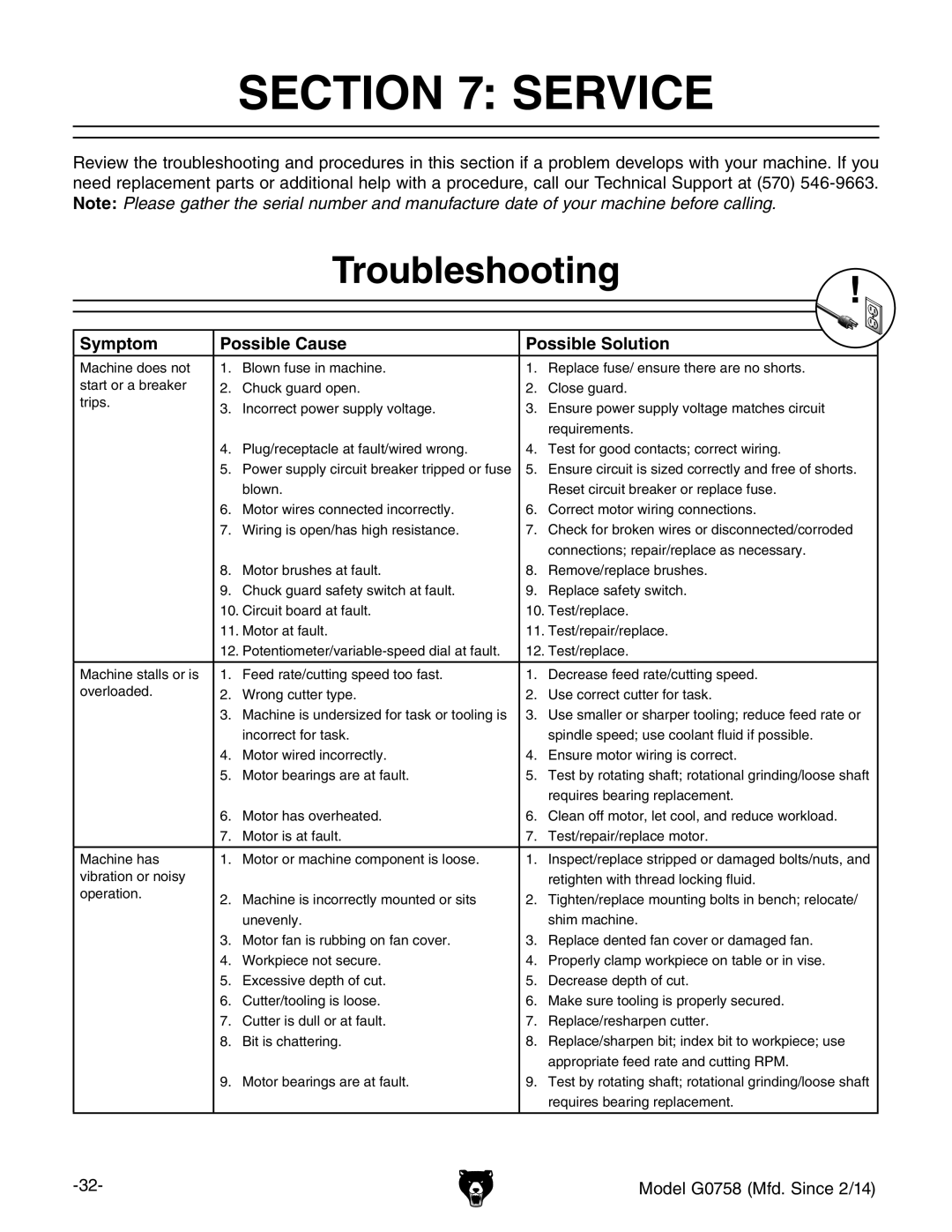
SECTION 7: SERVICE
Review the troubleshooting and procedures in this section if a problem develops with your machine. If you need replacement parts or additional help with a procedure, call our Technical Support at (570)
Troubleshooting
Symptom | Possible Cause | Possible Solution | ||
Machine does not | 1. | Blown fuse in machine. | 1. | Replace fuse/ ensure there are no shorts. |
start or a breaker | 2. | Chuck guard open. | 2. | Close guard. |
trips. | 3. | Incorrect power supply voltage. | 3. | Ensure power supply voltage matches circuit |
| ||||
|
|
|
| requirements. |
| 4. | Plug/receptacle at fault/wired wrong. | 4. | Test for good contacts; correct wiring. |
| 5. | Power supply circuit breaker tripped or fuse | 5. | Ensure circuit is sized correctly and free of shorts. |
|
| blown. |
| Reset circuit breaker or replace fuse. |
| 6. | Motor wires connected incorrectly. | 6. | Correct motor wiring connections. |
| 7. | Wiring is open/has high resistance. | 7. | Check for broken wires or disconnected/corroded |
|
|
|
| connections; repair/replace as necessary. |
| 8. | Motor brushes at fault. | 8. | Remove/replace brushes. |
| 9. | Chuck guard safety switch at fault. | 9. | Replace safety switch. |
| 10. Circuit board at fault. | 10. Test/replace. | ||
| 11. Motor at fault. | 11. Test/repair/replace. | ||
| 12. | 12. Test/replace. | ||
|
|
|
|
|
Machine stalls or is | 1. | Feed rate/cutting speed too fast. | 1. | Decrease feed rate/cutting speed. |
overloaded. | 2. | Wrong cutter type. | 2. | Use correct cutter for task. |
| 3. | Machine is undersized for task or tooling is | 3. | Use smaller or sharper tooling; reduce feed rate or |
|
| incorrect for task. |
| spindle speed; use coolant fluid if possible. |
| 4. | Motor wired incorrectly. | 4. | Ensure motor wiring is correct. |
| 5. | Motor bearings are at fault. | 5. | Test by rotating shaft; rotational grinding/loose shaft |
|
|
|
| requires bearing replacement. |
| 6. | Motor has overheated. | 6. | Clean off motor, let cool, and reduce workload. |
| 7. | Motor is at fault. | 7. | Test/repair/replace motor. |
|
|
|
|
|
Machine has | 1. | Motor or machine component is loose. | 1. | Inspect/replace stripped or damaged bolts/nuts, and |
vibration or noisy |
|
|
| retighten with thread locking fluid. |
operation. | 2. | Machine is incorrectly mounted or sits | 2. | Tighten/replace mounting bolts in bench; relocate/ |
| ||||
|
| unevenly. |
| shim machine. |
| 3. | Motor fan is rubbing on fan cover. | 3. | Replace dented fan cover or damaged fan. |
| 4. | Workpiece not secure. | 4. | Properly clamp workpiece on table or in vise. |
| 5. | Excessive depth of cut. | 5. | Decrease depth of cut. |
| 6. | Cutter/tooling is loose. | 6. | Make sure tooling is properly secured. |
| 7. | Cutter is dull or at fault. | 7. | Replace/resharpen cutter. |
| 8. | Bit is chattering. | 8. | Replace/sharpen bit; index bit to workpiece; use |
|
|
|
| appropriate feed rate and cutting RPM. |
| 9. | Motor bearings are at fault. | 9. | Test by rotating shaft; rotational grinding/loose shaft |
|
|
|
| requires bearing replacement. |
|
|
|
|
|
Model G0758 (Mfd. Since 2/14) |
